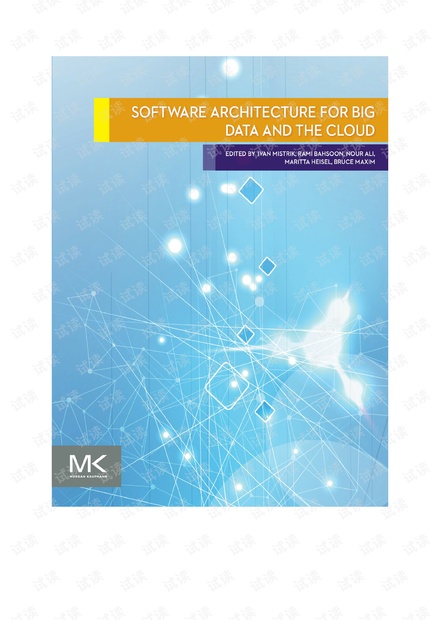没有合适的资源?快使用搜索试试~ 我知道了~
首页Software Architecture for Big Data and the Cloud 无水印pdf
Software Architecture for Big Data and the Cloud 无水印pdf
Software Architecture for Big Data and the Cloud 英文无水印pdf pdf所有页面使用FoxitReader和PDF-XChangeViewer测试都可以打开 本资源转载自网络,如有侵权,请联系上传者或csdn删除 本资源转载自网络,如有侵权,请联系上传者或csdn删除
资源详情
资源评论
资源推荐


Table of Contents
1. Cover image
2. Title page
3. Table of Contents
4. Copyright
5. Contributors
6. About the Editors
7. Foreword by Mandy Chessell
1. Amnesia or Progress?
8. Foreword by Ian Gorton
9. Preface
1. Introduction
2. Why a New Book on Software Architecture for Big Data and the
Cloud?
3. Book Outline
4. Part I: Concepts and Models
5. Part II: Analyzing and Evaluating
6. Part III: Technologies
7. Part IV: Resource Management
8. Part V: Looking Ahead
10. Chapter 1: Introduction. Software Architecture for Cloud and Big Data:
An Open Quest for the Architecturally Significant Requirements
1. Abstract
2. 1.1. A Perspective into Software Architecture for Cloud and Big
Data
3. 1.2. Cloud Architecturally Significant Requirements and Their
Design Implications
4. 1.3. Big Data Management as Cloud Architecturally Significant
Requirement
5. References
11. Part 1: Concepts and Models
1. Chapter 2: Hyperscalability – The Changing Face of Software
Architecture
1. Abstract

2. 2.1. Introduction
3. 2.2. Hyperscalable Systems
4. 2.3. Principles of Hyperscalable Systems
5. 2.4. Related Work
6. 2.5. Conclusions
7. References
2. Chapter 3: Architecting to Deliver Value From a Big Data and
Hybrid Cloud Architecture
1. Abstract
2. 3.1. Introduction
3. 3.2. Supporting the Analytics Lifecycle
4. 3.3. The Role of Data Lakes
5. 3.4. Key Design Features That Make a Data Lake Successful
6. 3.5. Architecture Example – Context Management in the IoT
7. 3.6. Big Data Origins and Characteristics
8. 3.7. The Systems That Capture and Process Big Data
9. 3.8. Operating Across Organizational Silos
10. 3.9. Architecture Example – Local Processing of Big Data
11. 3.10. Architecture Example – Creating a Multichannel View
12. 3.11. Application Independent Data
13. 3.12. Metadata and Governance
14. 3.13. Conclusions
15. 3.14. Outlook and Future Directions
16. References
3. Chapter 4: Domain-Driven Design of Big Data Systems Based on a
Reference Architecture
1. Abstract
2. 4.1. Introduction
3. 4.2. Domain-Driven Design Approach
4. 4.3. Related Work
5. 4.4. Feature Model of Big Data Systems
6. 4.5. Deriving the Application Architectures and Example
7. 4.6. Conclusion
8. References
4. Chapter 5: An Architectural Model-Based Approach to Quality-
Aware DevOps in Cloud Applicationsc
1. Abstract

2. 5.1. Introduction
3. 5.2. A Cloud-Based Software Application
4. 5.3. Differences in Architectural Models Among Development
and Operations
5. 5.4. The iObserve Approach
6. 5.5. Addressing the Differences in Architectural Models
7. 5.6. Applying iObserve to CoCoME
8. 5.7. Limitations
9. 5.8. Related Work
10. 5.9. Conclusion
11. References
5. Chapter 6: Bridging Ecology and Cloud: Transposing Ecological
Perspective to Enable Better Cloud Autoscaling
1. Abstract
2. Acknowledgement
3. 6.1. Introduction
4. 6.2. Motivation
5. 6.3. Natural Ecosystem
6. 6.4. Transposing Ecological Principles, Theories and Models
to Cloud Ecosystem
7. 6.5. Ecology-Inspired Self-Aware Pattern
8. 6.6. Opportunities and Challenges
9. 6.7. Related Work
10. 6.8. Conclusion
11. References
12. Part 2: Analyzing and Evaluating
1. Chapter 7: Evaluating Web PKIs
1. Abstract
2. 7.1. Introduction
3. 7.2. An Overview of PKI
4. 7.3. Desired Features and Security Concerns
5. 7.4. Existing Proposals
6. 7.5. Observations
7. 7.6. Conclusion
8. References
2. Chapter 8: Performance Isolation in Cloud-Based Big Data
Architectures

1. Abstract
2. 8.1. Introduction
3. 8.2. Background
4. 8.3. Case Study and Problem Statement
5. 8.4. Performance Monitoring in Cloud-Based Systems
6. 8.5. Application Framework for Performance Isolation
7. 8.6. Evaluation of the Framework
8. 8.7. Discussion
9. 8.8. Related Work
10. 8.9. Conclusion
11. References
3. Chapter 9: From Legacy to Cloud: Risks and Benefits in Software
Cloud Migration
1. Abstract
2. 9.1. Introduction
3. 9.2. Research Method
4. 9.3. Results
5. 9.4. Discussion
6. 9.5. Conclusion
7. References
4. Chapter 10: Big Data: A Practitioners Perspective
1. Abstract
2. 10.1. Big Data Is a New Paradigm – Differences With
Traditional Data Warehouse, Pitfalls and Consideration
3. 10.2. Product Considerations for Big Data – Use of Open
Source Products for Big Data, Pitfalls and Considerations
4. 10.3. Use of Cloud for hosting Big Data – Why to Use Cloud,
Pitfalls and Consideration
5. 10.4. Big Data Implementation – Architecture Definition,
Processing Framework and Migration Pattern From Data
Warehouse to Big Data
6. 10.5. Conclusion
7. References
13. Part 3: Technologies
1. Chapter 11: A Taxonomy and Survey of Stream Processing
Systems
1. Abstract
剩余788页未读,继续阅读
yinkaisheng-nj
- 粉丝: 763
- 资源: 6953
上传资源 快速赚钱
 我的内容管理
收起
我的内容管理
收起
 我的资源
快来上传第一个资源
我的资源
快来上传第一个资源
 我的收益 登录查看自己的收益
我的收益 登录查看自己的收益 我的积分
登录查看自己的积分
我的积分
登录查看自己的积分
 我的C币
登录后查看C币余额
我的C币
登录后查看C币余额
 我的收藏
我的收藏  我的下载
我的下载  下载帮助
下载帮助

会员权益专享
最新资源
- RTL8188FU-Linux-v5.7.4.2-36687.20200602.tar(20765).gz
- c++校园超市商品信息管理系统课程设计说明书(含源代码) (2).pdf
- 建筑供配电系统相关课件.pptx
- 企业管理规章制度及管理模式.doc
- vb打开摄像头.doc
- 云计算-可信计算中认证协议改进方案.pdf
- [详细完整版]单片机编程4.ppt
- c语言常用算法.pdf
- c++经典程序代码大全.pdf
- 单片机数字时钟资料.doc
- 11项目管理前沿1.0.pptx
- 基于ssm的“魅力”繁峙宣传网站的设计与实现论文.doc
- 智慧交通综合解决方案.pptx
- 建筑防潮设计-PowerPointPresentati.pptx
- SPC统计过程控制程序.pptx
- SPC统计方法基础知识.pptx
资源上传下载、课程学习等过程中有任何疑问或建议,欢迎提出宝贵意见哦~我们会及时处理!
点击此处反馈



安全验证
文档复制为VIP权益,开通VIP直接复制
 信息提交成功
信息提交成功
评论2